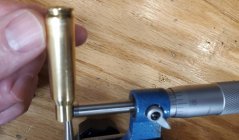P1ZombieKiller
Silver $$ Contributor
1 possible reason for this might be that once brass is fired, it's very hard (not impossible) to get the entire neck small enough to fit perfectly on your turning mandrel.
If not perfectly on your turning mandrel, and loose, the brass "slops" around (think wobbles), thus causing your cutter to cut more brass in other places that it didn't cut into before.
For me and my set up, I won't turn fired brass because once it's fired (and expanded) i can't reduce the whole neck down to my turning mandrel size.
If not perfectly on your turning mandrel, and loose, the brass "slops" around (think wobbles), thus causing your cutter to cut more brass in other places that it didn't cut into before.
For me and my set up, I won't turn fired brass because once it's fired (and expanded) i can't reduce the whole neck down to my turning mandrel size.












